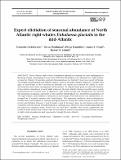Files in this item
Expert elicitation of seasonal abundance of North Atlantic right whales Eubalaena glacialis in the mid-Atlantic
Item metadata
| dc.contributor.author | Oedekoven, Cornelia Sabrina | |
| dc.contributor.author | Fleishman, Erica | |
| dc.contributor.author | Hamilton, Philip | |
| dc.contributor.author | Clark, James S. | |
| dc.contributor.author | Schick, Robert Schilling | |
| dc.date.accessioned | 2015-12-22T15:10:04Z | |
| dc.date.available | 2015-12-22T15:10:04Z | |
| dc.date.issued | 2015 | |
| dc.identifier | 218429522 | |
| dc.identifier | d71982c8-94c3-490a-a2cc-8bb09a992284 | |
| dc.identifier | 84954349920 | |
| dc.identifier | 000365699600005 | |
| dc.identifier.citation | Oedekoven , C S , Fleishman , E , Hamilton , P , Clark , J S & Schick , R S 2015 , ' Expert elicitation of seasonal abundance of North Atlantic right whales Eubalaena glacialis in the mid-Atlantic ' , Endangered Species Research , vol. 29 , no. 1 , pp. 51-58 . https://doi.org/10.3354/esr00699 | en |
| dc.identifier.issn | 1863-5407 | |
| dc.identifier.other | ORCID: /0000-0002-5610-7814/work/61978850 | |
| dc.identifier.uri | https://hdl.handle.net/10023/7921 | |
| dc.description | This work was supported in part by US Office of Naval Research (ONR) grants to E.F.: N00014-09-1-0896 at University of California, Santa Barbara and N00014-12-1-0274 at University of California, Davis. This work was also supported by ONR grant N000141210286 to the University of St Andrews. In addition, we gratefully acknowledge funding for this work from The Marine Alliance for Science and Technology for Scotland (MASTS). MASTS is funded by the Scottish Funding Council (grant reference HR09011) and contributing institutions. | en |
| dc.description.abstract | North Atlantic right whales (Eubalaena glacialis; henceforth right whales) are among the most endangered large whales. Although protected since 1935, their abundance has remained low. Right whales occupy the Atlantic Ocean from southern Greenland and the Gulf of St. Lawrence south to Florida. The highly industrialized mid-Atlantic region is part of the species’ migratory corridor. Gaps in knowledge of the species’ movements through the mid-Atlantic limit informed management of stressors to the species. To contribute to filling of these gaps, we elicited estimates of the relative abundance of adult right whales in the mid-Atlantic during four months, representing each season, from ten experts. We elicited the minimum, maximum, and mode as the number of individuals in a hypothetical population of 100 right whales, and confidence estimates as percentages. For each month-sex combination, we merged the ten experts’ answers into one distribution. The estimated modes of relative abundances of both sexes were highest in January and April (females, 29 and 59; males, 22 and 23) and lowest in July and October (females, five and nine; males, three and five). In some cases, our elicitation results were consistent with the results of studies based on sightings data. However, these studies generally did not adjust for sampling effort, which was low and likely variable. Our results supplement the results of these studies and will increase the accuracy of priors in complementary Bayesian models of right whale abundances and movements through the mid-Atlantic. | |
| dc.format.extent | 716533 | |
| dc.language.iso | eng | |
| dc.relation.ispartof | Endangered Species Research | en |
| dc.subject | Merged distributions | en |
| dc.subject | Migratory corridor | en |
| dc.subject | Survival | en |
| dc.subject | Triangular distributions | en |
| dc.subject | Weighting estimates | en |
| dc.subject | QA Mathematics | en |
| dc.subject | GE Environmental Sciences | en |
| dc.subject | NDAS | en |
| dc.subject.lcc | QA | en |
| dc.subject.lcc | GE | en |
| dc.title | Expert elicitation of seasonal abundance of North Atlantic right whales Eubalaena glacialis in the mid-Atlantic | en |
| dc.type | Journal article | en |
| dc.contributor.sponsor | Office of Naval Research | en |
| dc.contributor.institution | University of St Andrews. School of Mathematics and Statistics | en |
| dc.contributor.institution | University of St Andrews. Centre for Research into Ecological & Environmental Modelling | en |
| dc.identifier.doi | 10.3354/esr00699 | |
| dc.description.status | Peer reviewed | en |
| dc.identifier.grantnumber | N00014-12-1-0286 | en |
This item appears in the following Collection(s)
Items in the St Andrews Research Repository are protected by copyright, with all rights reserved, unless otherwise indicated.

